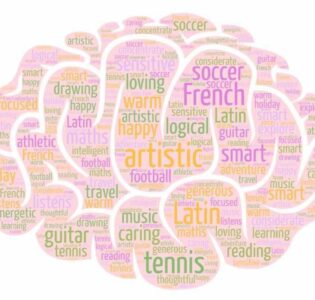Digital technology design program fosters connection to school and deeper learning.
Integrating RE and Digital Technologies: An Innovative App Prototyping Project
By Sarah Gale, Leader of Digital Technologies and Teacher of Religious Education, Genazzano FCJ College, Kew
Year 7 at Genazzano FCJ College, Kew, is an exciting time for our students and the perfect opportunity to introduce innovative practice to inspire inquiring minds. An App Prototyping Project was designed to bring together student learning in Religious Education and in Digital Technologies, in particular the way students presented their learning. It incorporated aspects of the Digital Technologies curriculum within Religious Education classes, which were focused on connectedness to school community.
When students begin at the college we want them to feel a sense of belonging and understand our history. Through learning about the Sisters Faithful Companions of Jesus (FCJ), who founded the College, and the foundress of the Sisters FCJ, Blessed Marie Madeleine d’Houët, students can begin to feel a sense of belonging to the faith-filled community that is Genazzano FCJ College. The students immersed themselves in the history of the Sisters and rummaged through the archives in order to bring to life an app prototype that demonstrated their learning in this unit.
Aims of the project
The App Prototyping Project aimed to meet one of the intended outcomes of the College’s Annual Action Plan: that students are active participants in an engaging Religious Education curriculum. With the integration of the Digital Technologies curriculum, I hoped to enhance student engagement in Religious Education to support the overall goals of the College. It was also an opportunity to gain valuable data from our students about the idea of connectedness and belonging to a faith community, as well as the growth that students showed through using technology and prototyping.
The overarching question then became clear:
If the students are provided with a rigorous assessment task, how will this impact on their engagement in Religious Education and their sense of belonging to Genazzano FCJ College?
The project prioritised 21st century learning and the four Cs (Keane 2012):
- Critical thinking and problem-solving
- Effective communication
- Collaboration and team-building
- Creativity and innovation.
The Religious Education unit
The Religious Education unit, ‘Belonging to Genazzano’, addressed the content area of ‘Church and Community’ in the Catholic Education Melbourne (draft) Religious Education Curriculum Framework and three of the area’s learning descriptors for Years 7–10 (K&U 2, R&R, and P&CE). Through research into the history of the Sisters FCJ and their foundress, Blessed Marie Madeleine d’Houët, the students were prompted to:
- Explain the tradition of their school and its connection to the local and global Church community (Knowledge and Understanding – K&U 2)
- Interpret the actions of key people in the past and present Church who responded to a call to witness (Reasoning and Responding – R&R)
- Reflect on their contribution to the school community and plan ways to contribute to the global Church (Personal and Communal Engagement – P&CE).
Students were encouraged to work in groups to achieve a common goal of producing an app prototype that encompassed their learning for the unit.
Incorporating Digital Technologies
With the Digital Technologies Curriculum, we were focused on the Creating Digital Solutions strand, keeping in mind the overall achievement standard for Year 7 (and Year 8) and the need for students to:
- Understand how text, image and sound data can be represented and secured in digital systems and presented using digital systems
- Analyse and evaluate data from a range of sources to model solutions and create information
- Manage the collaborative creation of interactive ideas, information and projects and use appropriate codes of conduct when communicating online
- Design user experiences (and algorithms incorporating branching and iterations), and develop, test, and modify digital solutions.
Implementing the innovation

Genazzano FCJ College is blessed with a dedicated team of Religious Education staff, some of whom have been teaching RE for more than 30 years and some who even attended the College themselves. The idea to design an app in RE could have been met with resistance as it was new and disruptive to what had always been done. On the contrary, staff embraced this project and demonstrated commitment to the process. Staff knew that they would be supported and that ultimately, the teaching and learning component of the unit remained the same. It was simply the summative evidence of learning that was going to be vastly different. Instead of writing an essay and creating a poster, the students would prototype an app.
The unit began with the introduction of the project, by giving students the vision of where they were headed and the knowledge that every subsequent RE lesson would be relevant to their app. Engagement levels were high. Students were told that at the end of the unit they would be producing an app prototype that demonstrated their understanding of the history of our College, the Sisters FCJ and what makes us a faith-filled community.

After weeks of immersing themselves in the story of blessed Marie Madeleine D’Houët, visiting the archive room of the College and interviewing our archivist, connecting with alumnae, reaching out to the Sisters FCJ, asking questions of our College Principal Karen Jebb, emailing College prefects, visiting the chapel, analysing artwork and statues that are placed around the grounds, learning about the architecture of the Wardell building, reading vast amounts of information on the Sisters FCJ and their mission, and knowing the story of the six women from whom our sporting houses take their names – finally the apps were ready to be designed!
Students worked through the design cycle to brainstorm, plan, prototype and evaluate their app and worked together to build their prototype in Keynote, an Apple presentation tool. Keynote is used by designers in the real world when prototyping; however, programs such as POP – Prototyping on Paper, PowerPoint or Google Slides could also be used. Essentially, the students’ creation looked and functioned like a real app, but did not have the complex coding behind it.
Students were guided by the creation of their ‘app statement’, which required them to think about who their app is for and what it will do. One example from a student stated that:
‘Our app aims to entertain and inform new students about the history and culture of our College in order to retain the memories from the past through interviews, quizzes, photographs and stories.’
I attended classes to team-teach with the Year 7 RE staff as students worked through the design cycle and began to prototype their app. I assisted with the setting-up of their document in Keynote and showed the students a few quick tips and tricks on how to create buttons as links, insert sounds and create a quiz.
From one short teacher-led tutorial grew creative prototypes that the students were extremely proud of. So much so that they would be constantly asking me ‘When do we have RE again!?’ and were running up to their RE teachers to show them the latest information they had added into their app.
For two weeks the students worked in groups to bring their learning to life through their app, completing their design booklet and using Keynote to create their prototype. The results were beyond what any staff member, including myself, could have anticipated. As teachers we simply planted the seed, and the students with their engagement and enthusiasm enabled this project to grow into something really special.
Analysing the results
The pre- and post-data that I collected really speak for themselves. I surveyed the entire Year 7 cohort and overall, students felt increased connectedness to the College: their sense of belonging increased, as did their historical knowledge. Their technical skills when prototyping improved and students were engaged with their RE lessons.
This is the second year that the students of Year 7 have participated in the App Prototyping Project and the momentum and excitement were still strong. This time, teachers felt confident to present the project with minimal assistance from me and it was clear they saw the value in the project based on last year’s success.
Subsequently, other year levels and subject areas have also experimented with the idea of app prototyping as a means of showcasing student learning and overall teachers have embraced this as a tool to engage students with tasks that speak to them in their digital world.
Reference
Keane, Therese 2012, ‘21st Century Skills = 3Rs + 4Cs’, The Australian Educational Leader, 34 (2), 44.
Sarah Gale can be contacted at 8862 1000 or [email protected].
This article was published in CEM Directors enews Vol 9 No 9 Jun 2019




